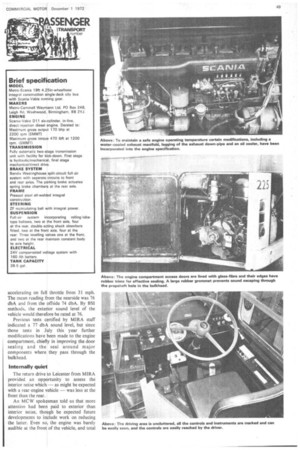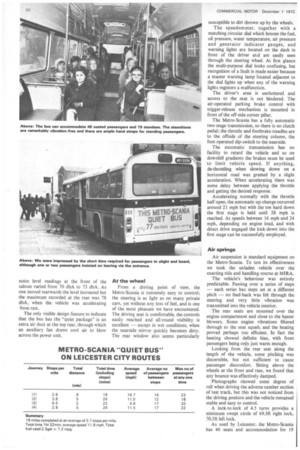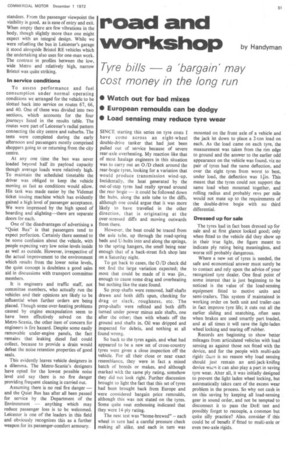ON THE LEICESTER FRONT
Page 50

Page 51

Page 52

Page 53

If you've noticed an error in this article please click here to report it so we can fix it.
The
The Metro-Scania Quiet Bus appraised in service by Trevor Longcroft YOU CAN'T WIN! Sitting in Leicester Corporation Transport's Metro-Scania Quiet Bus last week, towards the end of a special CM trial, we overheard a newly joined passenger say: This bus it too b ...... quiet; I nearly missed it!"
How quiet? Well, the bus carries a prominent message claiming only 77 decibels (dbA) but when we completed exterior noise tests in far from ideal conditions it returned an even better reading of 76 dbA. This is not only far below the current 89 dbA requirement but very much quieter than the proposed 86 dbA limit; which has been postponed. And our tests at MIRA were on a wet tarmacadem surface which accentuated tyre noise: in drier conditions we would almost certainly have recorded an even better figure.
To date, this is the only Quiet Bus version of the Metro-Scania in service in Britain, and is one of 35 buses of this make being operated by Leicester. It is being evaluated within the 204-bus fleet, about half of which are one-man operated. However, the "quiet package" will in future be fitted by MC W as standard on all Metro-Scania buses sold in this country and the package will account for £350 £400 of the new list price.
The vehicle differs from the previous standard model in having modifications to reduce the escape of unwanted sound from the engine compartment -and nd
consequential modifications to the engine since it is almost totally encapsulated Photographs and captions with this featurt explain what has been done.
Leicester's general manager, Mr Leslit Smith, gave CM the facilities to assess tlu vehicle under typical operating conditions and we also took performance and noisg readings at the MIRA testing ground. k well as driving the unladen vehicle ova actual LCT routes we were able to ride or it while in service and to take fue consumption readings.
At MIRA we used the British Standard: test procedure to take noise readings. Threg external noise readings were taken frost each side of the vehicle while it wal
accelerating on full throttle from 31 mph. The mean reading from the nearside was 76 dbA and from the offside 74 dbA. By BSI methods, the exterior sound level of the vehicle would therefore be rated at 76.
Previous tests certified by MIRA staff indicated a 77 dbA sound level, but since those tests in July this year further modifications have been made to the engine compartment, chiefly in improving the door sealing and the seal around major components where they pass through the bulk head.
Internally quiet
The return drive to Leicester from MIRA provided an opportunity to assess the interior noise which — as might be expected with a rear-engine vehicle — was less at the front than the rear.
An MCW spokesman told us that more attention had been paid to exterior than interior noise, though he expected future developments to include work on reducing the latter. Even so, the engine was barely audible at the front of the vehicle, and total
noise level readings at the front of the saloon varied from 70 dbA to 73 dbA. As one moved rearwards the level increased but the maximum recorded at the rear was 78 dbA, when the vehicle was accelerating from rest.
The only visible design feature to indicate that the bus has the "quiet package" is an extra air duct at the top rear, through which an auxiliary fan draws cool air to blow across the power unit. At the wheel From a driving point of view, the Metro-Scania is extremely easy to control; the steering is as light as on many private cars, yet without any loss of feel, and is one of the most pleasant we have encountered. The driving seat is comfortable, the controls easily reached and all-round visibility is excellent — except in wet conditions, when the nearside mirror quickly becomes dirty. The rear window also seems particularly susceptible to dirt thrown up by the wheels.
The speedometer, together with a matching circular dial which houses the fuel, oil pressure, water temperature, air pressure and generator indicator gauges, and warning lights are located on the dash in front of the driver al,d are easily seen through the steering wheel. At first glance the multi-purpose dial looks confusing, but recognition of a fault is made easier because a master warning lamp located adjacent to the dial lights up when any of the warning lights registers a malfunction.
The driver's area is uncluttered and access to the seat is not hindered. The air-operated parking brake control with trigger-release mechanism is mounted in front of the off-side corner pillar.
The Metro-Scania has a fully automatic two-stage transmission, so there is no clutch pedal; the throttle and footbrake treadles are to the offside of the steering column, the foot-operated dip-switch to the nearside.
The automatic transmission has no facility to retard the vehicle and so on downhill gradients the brakes must be used to limit vehicle speed. If anything, de-throttling when slowing down on a horizontal road was greeted by a slight acceleration. When accelerating there was some delay between applying the throttle and getting the desired response.
Accelerating normally with the throttle half open, the automatic up-change occurred around 21 mph but with the toe hard down the first stage is held until 28 mph is reached. At speeds between 16 mph and 24 mph, depending on engine load, and with direct drive engaged the kick-down into the first stage can be successfully employed.
Air springs Air suspension is standard equipment on the Metro-Scania. To test its effectiveness we took the unladen vehicle over the exacting ride and handling course at MIRA.
The vehicle's behaviour was entirely predictable. Passing over a series of steps — each series has steps set at a different pitch — no feed-back was felt through the steering and very little vibration was transmitted into the vehicle interior.
The rear seats are mounted over the engine compartment and close to the heater blowers. Some engine vibrations filtered through to the seat squab, and the heating proved perhaps too efficient. In fact the heating showed definite bias, with front passengers being only just warm enough.
Looking from the rear seat along the length of the vehicle, some pitching was discernible, but not sufficient to cause passenger discomfort. Sitting above the wheels at the front and rear, we found that any bounce was effectively damped.
Photographs showed some degree of roll when driving the adverse camber section of test track, but this was not noticed from the driving position and the vehicle remained stable and easy to control.
A lock-to-lock of 4.5 turns provides a minimum swept circle of 69.5ft right lock, 70.5ft left lock.
As used by Leicester, the Metro-Sc ania has 46 seats and accommodation for 19 standees. From the passenger viewpoint the visibility is good, as is ease of entry and exit. When empty there are few vibrations in the body, though slightly more than one might expect with an integral design. While we were refuelling the bus in Leicester's garage it stood alongside Bristol RE vehicles which the undertaking also uses for one-man work. The contrast in profiles between the low, wide Metro and relatively high, narrow Bristol was quite striking.
In service conditions To assess performance and fuel consumption under normal operating conditions we arranged for the vehicle to be slotted back into service on routes 67, 66, and 40. One of these was divided into two sections, which accounts for the four journeys listed in the results table. The routes were part of Leicester's radial pattern connecting the city centre and suburbs. The tests were completed during the early afternoon and passengers mostly comprised shoppers going to or returning from the city centre.
At any one time the bus was never loaded beyond half its payload capacity though average loads were relatively high. To maintain the scheduled timetable the driver was obliged to keep the vehicle moving as fast as conditions would allow. His task was made easier by the Videmat ticket issuing machine which has evidently gained a high level of passenger acceptance. We were impressed by the high speed of boarding and alighting—there are separate doors for each.
One of the disadvantages of advertising a "Quiet Bus" is that passengers tend to expect perfection. Certainly there seemed to be some confusion about the vehicle, with people expecting very low noise levels inside as well as outside. However, irrespective of the actual improvement to the environment which results from the lower noise levels, the quiet concept is doubtless a good sales aid in discussions with transport committee members.
It is engineers and traffic staff, not committee members, who actually run the vehicles and their opinions are likely to be influential when further orders are being placed. Though some over-heating problems caused by engine encapsulation seem to have been effectively solved on the Metro-Scania, the other item of concern for engineers is fire hazard. Despite some easily removable under-engine panels, the fact 'remains that leaking diesel fuel could collect. because to provide a drain would defeat the noise retention properties of good seals.
This evidently leaves vehicle designers in a dilemma. The Metro-Scania's designers have opted for the lowest possible noise level and say there is no fire danger providing frequent cleaning is carried out.
Assuming there is no real fire danger — and the Quiet Bus has after all been passed for service by the Department of the Environment anything which may reduce passenger loss is to be welcomed. Leicester is one of the leaders in this field and obviously recognizes this as a further weapon for its passenger-comfort armoury.
































































































































